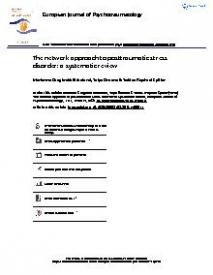The network approach to posttraumatic stress disorder : a systematic review
Background: The empirical literature of network analysis studies of posttraumatic stress symptoms (PTSS) has grown rapidly over the last years.
Objective: We aimed to assess the characteristics of these studies, and if possible, the most and least central symptoms and the strongest edges in the networks of PTSS.
Method: The present systematic review, conducted in PsycInfo, Medline, and Web of Science, synthesizes findings from 20 cross-sectional PTSS network studies that were accepted for publication between January 2010 and November 2018 (PROSPERO ID: CRD42018112825).
Results: Results indicated that the network studies investigated a broad range of samples and that most studies used similar analytic approaches including stability analysis. Only strength centrality was generally adequately stable. Amnesia was consistently reported to have lowest strength, while there was substantial heterogeneity regarding which nodes had highest strength centrality. The strongest edge weights were typically within each DSM-IV/DSM-5 PTSD symptom cluster.
Conclusions: Hypothesis-driven studies are needed to determine whether the heterogeneity in networks resulted from differences in samples or whether they are the product of underlying methodological reasons.
Geachte bezoeker,
De informatie die u nu opvraagt, kan door psychotraumanet niet aan u worden getoond. Dit kan verschillende redenen hebben,
waarvan (bescherming van het) auteursrecht de meeste voorkomende is. Wanneer het mogelijk is om u door te verwijzen naar de bron
van deze informatie, dan ziet u hier onder een link naar die plek.
Als er geen link staat, kunt u contact opnemen met de bibliotheek,
die u verder op weg kan helpen.
Met vriendelijke groet,
Het psychotraumanet-team.
In: European Journal of Psychotraumatology, ISSN 2000-8066 | 11 | 105 | 1700614
https://www.tandfonline.com/doi/pdf/10.1080/20008198.2019.1700614


